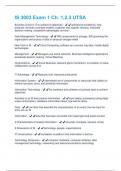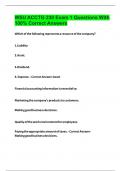IS 3003 Exam 1 Ch. 1,2,3 UTSA
Business invest in IT to achieve 6 objectives - ✔️✔️operational excellence, new
products, services, business models, customer and supplier intimacy, improved
decision making, competitive advantages, survival
Data Management Technology - ✔️✔️HW components for storage, SW governing the
organization and access of data on physical storage media
New Tech in IS - ✔️✔️Cloud Computing, software as a service, big data, mobile digital
technologies
Management - ✔️✔️Managers use social networks, Business intelligence applications
accelerate decision making, Virtual Meetings
Organizations - ✔️✔️Social Business, telework gains momentum, co-creation of value,
collaboration across firm
IT Advantage - ✔️✔️Reduces cost, improves productivity
Information System - ✔️✔️interrelated set of components or resources that collect (or
retrieve) process, store, and distribute information
Information Technology - ✔️✔️the hardware and software a business uses to achieve
objectives
Activities in an IS that produce information - ✔️✔️input (data), processing (using data),
output (information), feedback (information about how well its done)
Data - ✔️✔️raw facts that describe the characteristics of an event; the raw input for
entry into an IS
Information - ✔️✔️data that has been converted into meaningful and useful context
4 Characteristics of Quality Information - ✔️✔️accurate, complete, relevant, timely
3 Dimensions of IS - ✔️✔️technology, people, organizational
IT Infrastructure - ✔️✔️foundation or platform that information is built on
Technology Dimension - ✔️✔️computer hardware, computer software, data
management technology, networking and telecommunications technology
, Hardware - ✔️✔️physical components of an information system
Software - ✔️✔️the instructions that operate the information systenm
Networking and Telecommunications - ✔️✔️combination of HW and SW needed for
the electronic transmission of signals for data transfer and communications
People Dimension - ✔️✔️information systems require skilled people to build, maintain,
and use them
Organizational Dimension - ✔️✔️organizations coordinate work through business
processes, functional departments, a structured hierarchy
Business Process - ✔️✔️logically related sets of tasks that define how specific
business tasks are performed
Business Functions - ✔️✔️also referred to as departments
Business Hierarchy - ✔️✔️define levels of authority, decision making, responsibility,
and access to resources
Organizational Culture - ✔️✔️reflects the firms underlying assumptions and values,
way of doing things
4 Step Problem Solving Process - ✔️✔️Problem identification, Solution Design,
Solution Evaluation, Implementation
Critical Thinking - ✔️✔️sustained suspension of judgement with an awareness of
multiple perspectives and alternatives
Immediate Environment Factors - ✔️✔️customers, suppliers, competitors,
stockholders, regulations
Global Environment Factors - ✔️✔️Technology and science, economy, politics,
international change, regulation
Transaction Processing System (TPS) - ✔️✔️keeps track of basic activities and
transactions of the organization, serves operational managers and personnel, supports
routine, well-defined tasks
Proccessing - ✔️✔️the capturing of transaction and event data using technology to
process the data accordingly





